Discover 12 Iconic American Artists
- 1. Edward Hopper (1882-1967)
- 2. Georgia O'Keeffe (1887-1986)
- 3. Man Ray (1890-1976)
- 4. Norman Rockwell (1894-1978)
- 5. Mark Rothko (1903-1970)
- 6. Jackson Pollock (1912-1956)
- 7. Andy Warhol (1928-1987)
- 8. Keith Haring (1958-1990)
- 9. Jean-Michel Basquiat (1960-1988)
- 10. Jeff Koons (1955)
- 11. JonOne (1963)
- 12. Shepard Fairey (1970)
The American art world is a vibrant and ever-evolving landscape, home to an extensive network of galleries and studios across the country. With thousands of venues dedicated to showcasing artistic talent, the United States has become a global hub for contemporary art and its creators. In fact, America is home to a thriving community of more than 100,000 artists who have opened studios and seized the opportunity to leave their stamp on the country's extensive network of more than 1,500 galleries. Who Led the Way in Modern Art Innovation? This article dives into the heart of this dynamic scene, spotlighting the Top 12 American Artists who have significantly shaped its current state. From groundbreaking pioneers to contemporary visionaries, these artists' works span a diverse range of styles and mediums, reflecting the rich tapestry of American culture and creativity.
1. Edward Hopper (1882-1967)
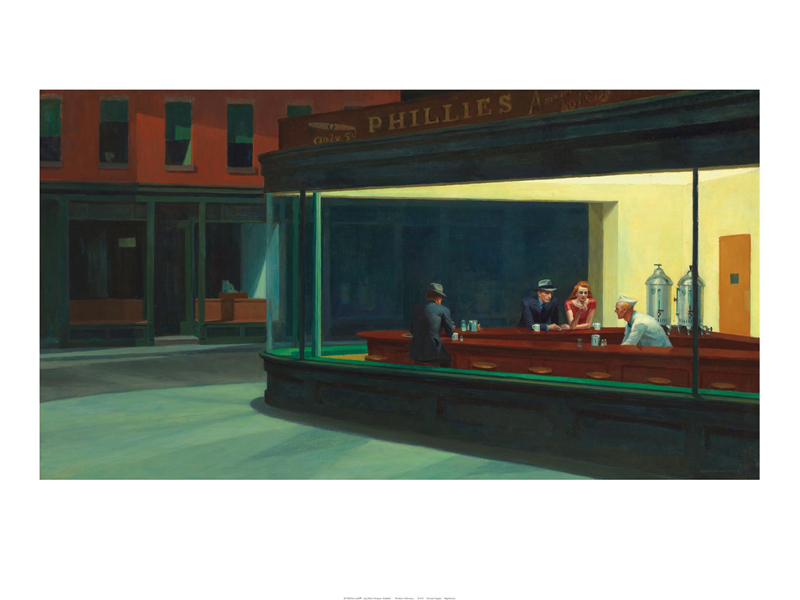
Edward Hopper "Nighthawks"
Edward Hopper, an iconic figure in 20th-century American art, profoundly captured the urban experience and the solitude of American life. With a focus on the mundane yet mystical aspects of everyday scenes, Hopper's work offers a window into the soul of urban America. Initially trained as an illustrator, he found his true calling in painting after being inspired by European Impressionists. Unlike his contemporaries who leaned towards Cubism, Hopper's inclination was towards naturalistic depictions of landscapes and urban life. His journeys to Europe enriched his palette, but it was in the United States where he truly honed his vision, painting evocative scenes of city life, landscapes, and interiors marked by a unique use of light and shadow.
Hopper's fascination with architecture led him to create exquisite watercolors of old buildings, capturing them at various times of day to explore the play of light. This attraction to luminosity and its variations became a hallmark of his work, particularly evident in pieces like "Nighthawks," where isolated individuals are depicted in a late-night diner setting, illuminated by a harsh, artificial light that both isolates and reveals.
Hopper's portrayal of the evolving American society, characterized by a pervasive sense of melancholy and isolation, positions him as a central figure in American realism. His subjects, alone, motionless persons in lonely metropolitan environments or barren landscapes, evoke regret for an America that is vanishing and becoming more and more urbanized and individualistic. Through his canvases, Hopper not only documented his era but also created a timeless exploration of human solitude and contemplation. His influence extends beyond painting, inspiring filmmakers and photographers with his dramatic interplay of light and shadow, and his ability to capture the profound in the ordinary.
2. Georgia O'Keeffe (1887-1986)

Georgia O'keeffe
Georgia O'Keeffe, renowned for her pioneering contributions to modern art through her iconic paintings of enlarged flowers, landscapes, and abstract forms, possesses a timeless artistic legacy. While primarily celebrated for her traditional mediums, O'Keeffe's visionary spirit and innovative approach to art make her a compelling candidate for exploration in the realm of digital art. In reimagining O'Keeffe's artistic journey through a digital lens, one can envision her translating her signature motifs into the digital realm with stunning effect. Using digital tools such as graphic design software and digital painting programs, O'Keeffe could infuse her distinctive style with new dimensions of color, texture, and scale. For instance, O'Keeffe's iconic flower paintings, known for their intimate examination of natural forms, could undergo a digital metamorphosis, with petals unfurling in mesmerizing detail on high-resolution screens. Through digital manipulation, she could experiment with exaggerated proportions and surreal compositions, inviting viewers to explore the intricate beauty of botanical specimens in a captivating new light.
Likewise, O'Keeffe's evocative landscapes, inspired by the vast expanses of the American Southwest, could undergo a digital transformation, with sweeping vistas rendered in immersive virtual reality experiences. Viewers could traverse rugged terrain, guided by O'Keeffe's keen eye for composition and color, as they navigate through digital recreations of iconic locales such as Ghost Ranch or the Chama River Valley. In addition to her representational works, O'Keeffe's abstract compositions could take on new life in the digital realm, with geometric forms and organic shapes pulsating with dynamic energy on interactive screens. Through digital animation techniques, she could imbue her abstract studies with a sense of movement and rhythm, inviting viewers into a mesmerizing dance of color and form. By embracing digital technology as a means of artistic expression, Georgia O'Keeffe could continue to push the boundaries of creativity and expand the possibilities of her artistic vision for generations to come.
3. Man Ray (1890-1976)
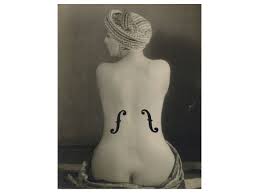
Man Ray "Le Violon D'ingres"
Man Ray, a pivotal figure in the Surrealist movement, embarked on a journey from industrial design to become an influential force in 20th-century art, particularly known for his groundbreaking work in photography. His early years in New York were marked by his engagement with Alfred Stieglitz's "291" gallery, where he was exposed to European avant-garde art, fueling his participation in the 1913 Armory Show that showcased modern art movements like Fauvism, Cubism, and Futurism. By 1915, after his first solo exhibition, Man Ray aligned with the Dada movement, born from the chaos of World War I, which espoused a radical rejection of conventional societal values.
Man Ray's relocation to Paris in 1921 marked a significant turn in his career as he stumbled upon "rayography," a technique that allowed him to produce enigmatic images by placing objects on light-sensitive paper. This period also saw his deep involvement with the Surrealist movement, enriching it with his innovative visual techniques. His collaboration with Lee Miller, his lover and assistant, introduced the art world to solarization, a method that reversed the dark and light areas of a photograph, adding a dreamlike quality to the images. Man Ray's contributions, particularly through "rayography" and solarization, cemented his legacy as a revolutionary figure in photography, adept at capturing the surreal and mystical qualities of the everyday. His work not only transcends the boundaries of photography but also serves as a testament to the transformative power of innovation in art.
His famous works include "Le Violon d'Ingres," a photograph melding a woman's back with a violin's f-holes, symbolizing objectification and art's intersection. "Rayographs" are unique camera-less images created by placing objects on photosensitive paper, showcasing his experimental approach to art. "Larmes (Tears)" captures the artificiality of cinema and photography through glass beads on a woman’s face, resembling tears, exploring themes of reality and illusion. These works underline Man Ray's mastery over visual language, transforming the ordinary into the extraordinary.
4. Norman Rockwell (1894-1978)

Norman Rockwell "Four Freedoms" 1943
The visual chronicle of American history from the interwar to postwar eras is provided by Norman Rockwell, who is well known for his famous magazine illustrations. With a passion for drawing ignited in his childhood, Rockwell commenced his formal art education at the American Academy of Design in New York at a mere 16 years old. He then continued to refine his technique at the prestigious Art Students League. Demonstrating remarkable talent, Rockwell began receiving commissions for illustrations from youth magazines even before reaching adulthood. However, it was the pivotal year of 1922 that catapulted his career when he landed his inaugural cover for the prestigious publication, The Saturday Evening Post. This marked the inception of a prolific 47-year collaboration, during which Rockwell crafted an additional 321 covers. Employing a realistic, almost photographic style, he captured the essence of everyday life in middle-class America with warmth and occasional humor, aligning him with the American regionalism movement.
As a result of Rockwell's dedication to the war effort, his pictures took on a patriotic zeal amid the chaos of World War II. Inspired by President Roosevelt's seminal Four Freedoms speech in 1943, Rockwell created a series of four paintings encapsulating the ideals of freedom of speech, freedom of worship, freedom from fear, and freedom from want. Through these poignant depictions of ordinary life, Rockwell sought to imbue Roosevelt's abstract concepts with tangible meaning, instilling hope and resilience in the American populace. Despite waning commissions in the ensuing years, as newspapers increasingly favored photography over illustrations, Rockwell remained steadfast in his dedication to using art as a platform for social commentary. Throughout his lifetime, he fervently championed causes such as civil rights, desegregation, poverty alleviation, and anti-war activism, establishing himself as one of the most politically engaged artists of his generation. Rockwell's enduring legacy transcends mere aesthetics, serving as a testament to the power of art to provoke thought, evoke emotion, and inspire societal change.
5. Mark Rothko (1903-1970)

Mark Rothko
Mark Rothko, celebrated for his profound exploration of color, form, and emotion in his iconic abstract paintings, presents a fascinating prospect as a digital artist. While Rothko's oeuvre is traditionally associated with large-scale canvases that envelop viewers in immersive color fields, his visionary approach to art could find new resonance in the digital realm. In envisioning Rothko's transition to digital art, one can imagine him harnessing digital tools to amplify the emotional impact of his work. Through digital painting software and immersive virtual reality technology, Rothko could create dynamic compositions that evoke a sense of transcendence and introspection. For instance, Rothko's signature stacked rectangles of vibrant color could be reimagined as interactive digital installations, where viewers are invited to navigate through layers of luminous hues with a swipe of their fingertips. By incorporating elements of interactivity, Rothko's digital works could offer viewers a deeper level of engagement, allowing them to explore the depths of his artistic vision in an entirely new way.
Furthermore, Rothko's exploration of color theory and the relationship between light and space could be elevated through digital manipulation. Using digital rendering techniques, he could experiment with the play of light and shadow, creating mesmerizing illusions of depth and movement within his compositions. In addition to his abstract paintings, Rothko's interest in the spiritual and metaphysical could find expression in digital installations that blur the boundaries between art and technology. Imagine immersive digital environments that envelop viewers in ethereal landscapes of light and color, inviting contemplation and reflection on the nature of existence.
6. Jackson Pollock (1912-1956)

Jackson Pollock, Painting (Silver On Black, White, Yellow And Red), 1948.
Jackson Pollock, an iconic figure in Abstract Expressionism renowned for his innovative technique of action painting, left an indelible mark on the landscape of contemporary American art. Despite achieving posthumous acclaim on a global scale, his tumultuous life story has perpetuated the myth of the tormented artist. Raised in challenging circumstances marked by the absence of his father and the dominant presence of his mother, Pollock battled alcoholism from an early age. A transformative encounter during his youth, when he visited an Indigenous reservation and encountered the abstract motifs of "primitive" art, profoundly influenced his artistic vision.
Pollock used art as a therapeutic release, a way to express his feelings and get over his inner anguish. His signature action paintings, akin to performative acts, prioritized the process of creation over the final product. During the Great Depression, Pollock experienced financial difficulties but was able to get help from the Federal Art Project, a New Deal program designed to encourage artistic undertakings. His drinking problems caused him to be kicked out of the program in 1938, even though he had previously painted murals. This prompted him to start the process of detoxifying. Pollock's breakthrough came in 1943 when he participated in a landmark exhibition organized by renowned art collector Peggy Guggenheim. Favorably received by esteemed figures such as Piet Mondrian and Marcel Duchamp, Pollock garnered significant recognition, leading to a lucrative arrangement with Guggenheim and his own dedicated exhibition. Embracing a radical approach, he pioneered the technique of "dripping" paint onto canvases, defying traditional conventions and embracing total abstraction.
Despite achieving unprecedented success, Pollock's personal demons continued to plague him. Tragically, his battle with alcoholism culminated in his untimely demise in a fatal car accident while driving under the influence. Nevertheless, his legacy endures, with his works revered and showcased in prestigious galleries worldwide, including editions available for viewing on platforms such as Artsper. Through his revolutionary approach to art, Pollock challenged the boundaries of creativity and forever altered the course of modern painting.
7. Andy Warhol (1928-1987)

Andy Warhol, "Untitled From Marilyn Monroe", 1967
Pop artist Andy Warhol, a pioneer in the field, transformed the way people saw art by making commonplace objects become symbols of culture and commercializing artistic expression at the same time. The son of Slovak immigrants, Warhol rose above the lowly beginnings of Pittsburgh's working class environment to overcome financial obstacles in order to obtain a formal Fine Arts education. Following his graduation, he migrated to New York in 1949, where he swiftly ascended the ranks of the commercial art scene, garnering acclaim for his contributions to fashion magazines and advertising campaigns.
In the late 1950s, Warhol transitioned his focus to painting, drawing initial inspiration from the graphics of comic books. However, it was his iconic depictions of consumer goods, notably Campbell's Soup cans, that etched his name into the annals of art history. Embracing silkscreen printing as a means to satisfy burgeoning demand, Warhol unleashed a flood of vibrant, mass-produced works onto the art world, punctuated by bold hues and repetitive motifs. His celebrity portraits, including the iconic portrayal of Marilyn Monroe, now grace the walls of prestigious modern art institutions worldwide. Establishing his legendary Factory in 1964, Warhol cultivated an avant-garde haven that doubled as a creative workshop and experimental film studio, embodying the pulse of New York's artistic zeitgeist. Celebrated as a luminary of Pop Art during his lifetime, Warhol's influence transcended mere artistic prowess, as he transitioned into a patron of the arts in the late 1980s. Collaborating with emerging talents such as Jean-Michel Basquiat and Keith Haring, Warhol transformed his name into a cultural brand, cementing his enduring legacy as an iconoclastic force within the art world.
8. Keith Haring (1958-1990)

Keith Haring, Necker Hospital, 1987
Renowned globally for his vibrant frescoes featuring colorful figures outlined in bold black strokes, Keith Haring remains celebrated not only for his artistic prowess but also for his unwavering commitment to combating homophobia and AIDS. Born in Pittsburgh, much like his contemporary Andy Warhol, Haring initially delved into the realm of advertising graphics. However, driven by a fervent desire to explore his own artistic vision, he ventured to New York, where the vibrant street art scene served as his muse. Embracing the ethos of taking art beyond traditional confines, Haring embarked on a grassroots campaign of chalk drawings on subway advertising boards, captivating passersby with his playful yet socially conscious imagery. Immersed in the avant-garde milieu of New York's underground, he transitioned from subway walls to gallery exhibitions, ultimately earning international acclaim, including an invitation to the prestigious 1985 Paris Biennale. Beneath the surface of his seemingly simplistic, childlike drawings lie profound explorations of pressing societal issues such as racism, violence, substance abuse, and environmental degradation. Leveraging the power of street art as a platform for social commentary, Haring strove to amplify marginalized voices and challenge prevailing prejudices. Engaging in art education initiatives and undertaking public commissions, such as his poignant fresco at Necker Hospital in 1987, he sought to inspire societal change.
Despite his own battle with AIDS, which he courageously confronted and utilized as a catalyst for advocacy, Haring remained steadfast in his dedication to the LGBTQ+ community and the broader fight against the disease. Establishing the Keith Haring Foundation in 1989, he endeavored to ensure his artistic legacy would endure as a beacon of hope and activism. Tragically, his life was cut short at the age of 31, yet the impact of his art and activism continues to reverberate, leaving an indelible mark on both the artistic landscape and social consciousness.
9. Jean-Michel Basquiat (1960-1988)
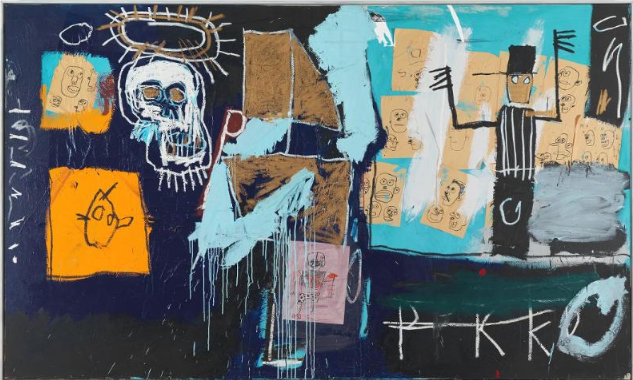
Jean-michel Basquiat, Slave Auction, 1982.
Jean-Michel Basquiat stands as one of the most renowned African-American artists, even posthumously commanding record-breaking prices. In 2017, nearly three decades after his passing, one of his works fetched over 110 million euros at auction, solidifying his status as one of the world's most valuable American artists. Born in Brooklyn to a Haitian father and a Hispanic mother, Basquiat exhibited a prodigious talent for drawing from a young age, creating his initial graffiti pieces at just 16 under the pseudonym SAMO ("Same Old Shit"). Defying societal norms with a rebellious spirit, Basquiat rejected conformity and aspired to become the first internationally recognized black artist. His aspirations found validation when he caught the attention of his idol, Andy Warhol, who facilitated introductions to influential New York gallery owners.
Basquiat's works, marked by their distinctive style, evoke a sense of both fascination and unease, often characterized by themes of violence and mortality infused with tribal motifs reflective of his cultural heritage. Through his art, he confronted issues of identity and systemic oppression, presenting a chaotic world imbued with potent symbolism. A child of Pop culture, Basquiat seamlessly integrated diverse techniques such as graffiti, painting, and collage, transcending conventional artistic boundaries. His untimely demise at the age of 28 due to a drug overdose cut short a remarkably prolific career, during which he produced over 800 paintings and 1,500 drawings. Despite his meteoric rise, Basquiat's inner turmoil, palpable in the raw intensity of his compositions, tragically contributed to both his success and downfall.
10. Jeff Koons (1955)
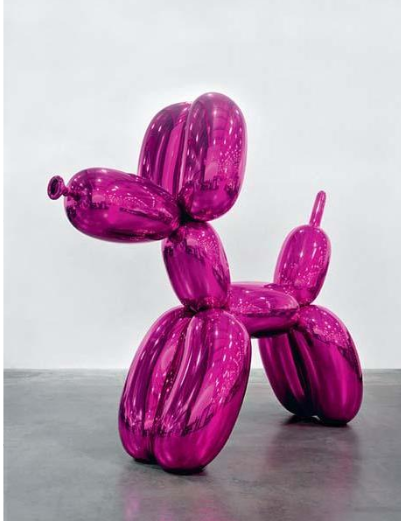
Jeff Koons, Balloon Dog, 1994–2000
Jeff Koons, hailed as one of the preeminent American artists of the 21st century, also ranks among the most polarizing figures in the art world. While his creations are revered by some as groundbreaking industrial art, others dismiss them as mere replicas. Yet, despite the controversies, Koons's works command astronomical prices and adorn the walls of prestigious art institutions worldwide, marking a testament to his unparalleled success.
Nurturing a passion for art from a tender age, Koons initially faced setbacks with his early endeavors, leading him to pursue a career as a financial broker. However, it wasn't until the 1980s that he achieved widespread acclaim with his monumental sculptures, notably his iconic Balloon Dogs and Inflatable Rabbits, capturing the attention of discerning collectors. Emulating the model of Andy Warhol, Koons established a studio in New York, eventually evolving into a veritable factory with over a hundred employees, where his creations are meticulously crafted, albeit no longer by his own hands. Inspired by the ready-mades of Marcel Duchamp, Jeff Koons's stainless steel works draw inspiration from Pop Art traditions while reimagining commonplace things with an industrial look. Although Warhol brought art into the industrial age, it was Koons who thrust it into the global arena. His gaudy emblems have become part of cultures all around the world, though not without causing controversy.
His exhibitions, such as the 2008 showcase at the Palace of Versailles, sparked debates over the preservation of "French artistic purity," while his Bouquet of Tulips installation faced criticism for its perceived intrusion into public space. Additionally, Koons has faced accusations of plagiarism for appropriating subjects from existing photographs and advertisements. However, it seems that his career in the art world is set to continue to prosper, as demonstrated by the extraordinary 91.1 million euro sale of his Rabbit sculpture in May 2019, which made him the most expensive living artist in the world.
11. JonOne (1963)
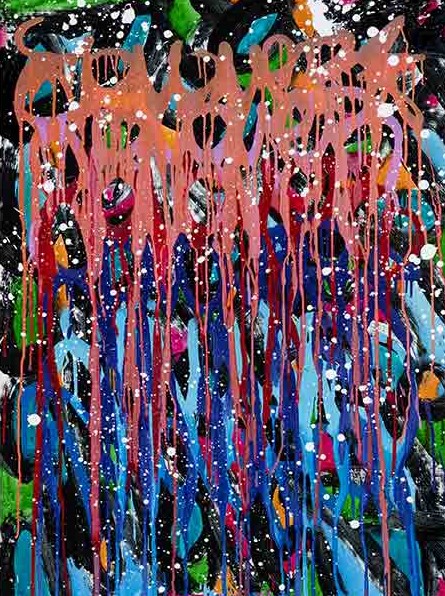
Jonone, Miracles, 2020
JonOne emerges as an important figure in the realm of abstract expressionism within the graffiti scene, drawing inspiration from the legacies of both Jackson Pollock and Jean-Michel Basquiat. Born and bred in the vibrant streets of Harlem, New York City, JonOne's journey mirrors that of his predecessors, navigating the urban landscape with an irrepressible artistic spirit. He developed his skills in the maze-like subway systems during his teenage years, painting his first tags there. He saw the city's transportation network as a living, breathing picture, much like a large museum. A fateful encounter with French graffiti luminary Bando catalyzed JonOne's trajectory, leading him to relocate to Paris in the 1990s. There, amidst the bustling streets and eclectic ateliers of the City of Light, he unleashed his creative fervor, blending the raw energy of his New York roots with the cosmopolitan allure of his newfound home. His early works, birthed in the confines of the Ephemeral Hospital workshop, swiftly garnered attention from the Parisian art elite, propelling him into the spotlight of the French contemporary art scene.
A colorful universe where imagination reigns supreme is revealed to spectators through JonOne's work, which pulsates with a profound sensitivity and poetic resonance. Eschewing figurative constraints, he surrenders to the fluidity of movement, color, and urban energy, allowing his emotions to unfurl across the canvas in a vibrant symphony of hues. In his compositions, streaks of vivid spontaneity intersect with the rhythmic pulse of the metropolis, blurring the boundaries between lyrical abstraction and urban expressionism. A testament to the enduring legacy of American artists, JonOne's work serves as a beacon of renewal within the contemporary art landscape. With each brushstroke, he channels the spirit of his predecessors while forging a path uniquely his own, ensuring that the hegemony of American artistic innovation remains vibrant and enduring. As JonOne continues to push the boundaries of expression, his ascent solidifies the indelible imprint of American artistry on the global stage.
12. Shepard Fairey (1970)

Shepard Fairey, Hope, 2008
Renowned for crafting Barack Obama's iconic campaign poster during the historic 2008 presidential election, Shepard Fairey has transcended the realm of street art to become a potent force in political and contemporary discourse. Honored by the Boston Institute of Contemporary Art as the most influential street artist, Fairey's journey from designing t-shirts and skateboards as a teenager to his current status as a prominent figure in the art world is a testament to his indomitable spirit and creative vision. Entering the Rhode Island School of Design in 1989, Fairey's penchant for provocative imagery began to take shape. Collaborating with fellow students, he unleashed a series of stickers and posters featuring the likeness of French wrestler André the Giant, igniting a global phenomenon. In 1998, imbuing the image with the word "Obey," he transformed this subversive visual into his signature propaganda parody.
However, it was Fairey's Hope poster that catapulted him to international acclaim. Advocating for the future president Barack Obama, he produced a series of posters culminating in a striking portrait of the politician adorned in the colors of the American flag. Symbolizing hope and progress, this emblematic image graced the front pages of magazines and found a permanent home in the National Portrait Gallery in Washington. Continuing his artistic endeavors, Fairey has adorned cityscapes with vibrant murals, including poignant works in Paris's 13th arrondissement, such as a depiction of Marianne surrounded by the national motto "Liberty, Equality, Fraternity" following the tragic events of November 13, 2015. His unwavering commitment to democracy and civil liberties remains steadfast, exemplified by his recent activism opposing the election of Donald Trump with a revised slogan of "Nope."
Celebrating three decades of artistic innovation, Fairey's legacy was honored at the Grenoble Street Art Fest in 2019, solidifying his place in the international artistic and urban landscape. From political activism to urban revitalization, Shepard Fairey's impact reverberates far beyond the confines of traditional art spaces, embodying the power of art to inspire change and ignite social consciousness.
To understand the progression of artistic expression in the digital era, one must understand American digital artists. Through their work, the intersections of art, technology, and culture are illuminated, offering insights into the issues and values of modern society. We learn to appreciate the diversity and inventiveness of the art world by studying these artists because they frequently defy expectations and push limits!
No Comments Yet...